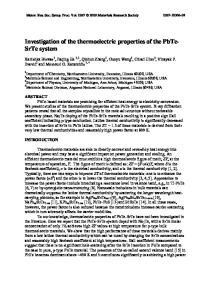Structural analysis and thermoelectric properties of Type-I clathrate compounds in the Ba-Ge-Ga system
- PDF / 1,160,361 Bytes
- 6 Pages / 612 x 792 pts (letter) Page_size
- 26 Downloads / 308 Views
S7.6.1
Structural analysis and thermoelectric properties of Type-I clathrate compounds in the Ba-Ge-Ga system Norihiko L. Okamoto, Takumi Nishii, Min Wook Oh and Haruyuki Inui Department of Materials Science and Engineering, Kyoto University Sakyo-ku, Kyoto 606-8501, Japan ABSTRACT The crystal structure and thermoelectric properties of Type-I clathrate compounds in the Ba-Ge-Ga system (Ba8GaXGe46-X) have been investigated as a function of Ga content. While all ternary compounds containing more than 3 Ga exhibit a crystal structure of normal Type-I clathrates with the space group Pm 3 n, the binary compound possesses a composition Ba8Ge43, which is leaner in Ge than the stoichiometric composition, and has a crystal structure different from that of normal Type-I clathrates because of the ordering of Ge vacancies in 6c sites of the parent normal Type-I clathrate structure. The temperature dependence of electrical resistivity of binary Ba8Ge43 is of semiconductor while that for all the ternary compounds is metallic. The value of Seebeck coefficient increases with the increase in the Ga content. The value of dimensionless figure of merit (ZT) increases with the increase in the Ga content, exhibiting a high value of 0.76 at 700°C for Ba8Ga16Ge30. INTRODUCTION Clathrate compounds possess polyhedral cages encapsulating guest atoms. The cages consist of group IV elements, Si, Ge or Sn, although Al, Ga, In, As or Sb can also be substituted for these elements to some degree. The guest atoms are typically alkali metals or alkali-earth metals. Clathrate compounds generally show a low thermal conductivity and have been investigated in a great endeavor in hopes of producing more efficient thermoelectric devices [1-3]. The low thermal conductivity of clathrate compounds is explained by Slack with the concept of PGEC (Phonon-Glass, Electron-Crystal) as in filled-skutterudite compounds that also have a crystal structure consisting of polyhedral cages and encapsulated guest atoms [4]. In this concept, guest atoms are “rattling” in polyhedral cages and scatter the heat-carrying phonons, resulting in the amorphous-like low thermal conductivity. Among clathrate compounds with a variety of structure types resulting from the difference in the constituent cages, the Type-I clathrate compounds have mainly been studied for thermoelectric materials. The Type-I structure comprises 2 pentagonal dodecahedra and 6 tetrakaidecahedra formed by 12 pentagonal and 2 hexagonal faces. The corresponding unit cell is cubic with the space group of Pm 3 n (No.223). The Type-I clathrate compounds possess in general a composition of M8X46, where M stands for guest atoms and X for atoms making up polyhedral cages. Guest atoms are located at the center of cages whose framework is consist of 6c, 16i and 24k crystallographic sites. It has been reported that substituted atoms preferentially occupy the 6c sites. Therefore, the occupancy behavior of the 6c sites may play an important role in controlling its physical properties. In fact, Herrmann et al. [5] inferred
Data Loading...











